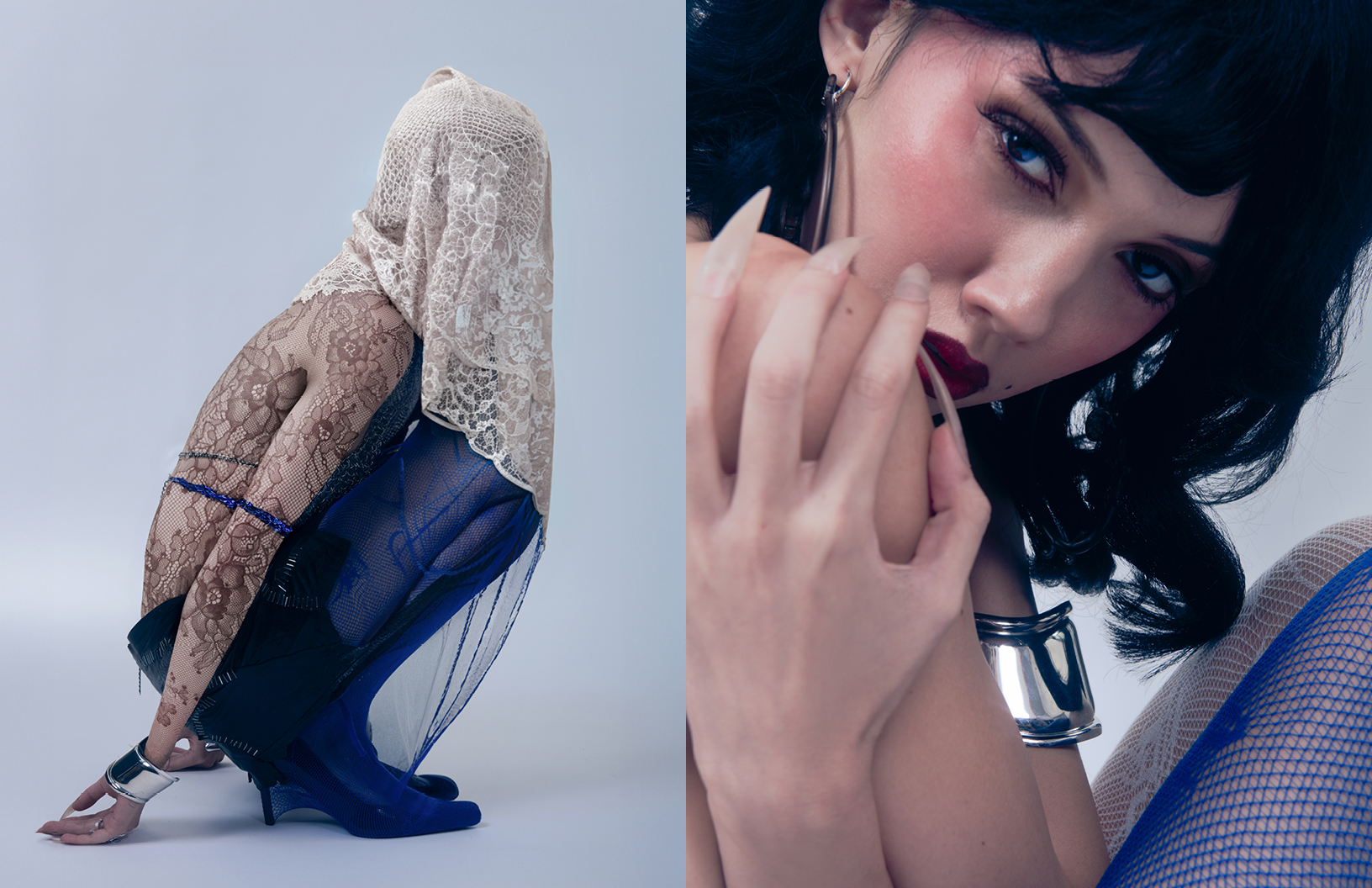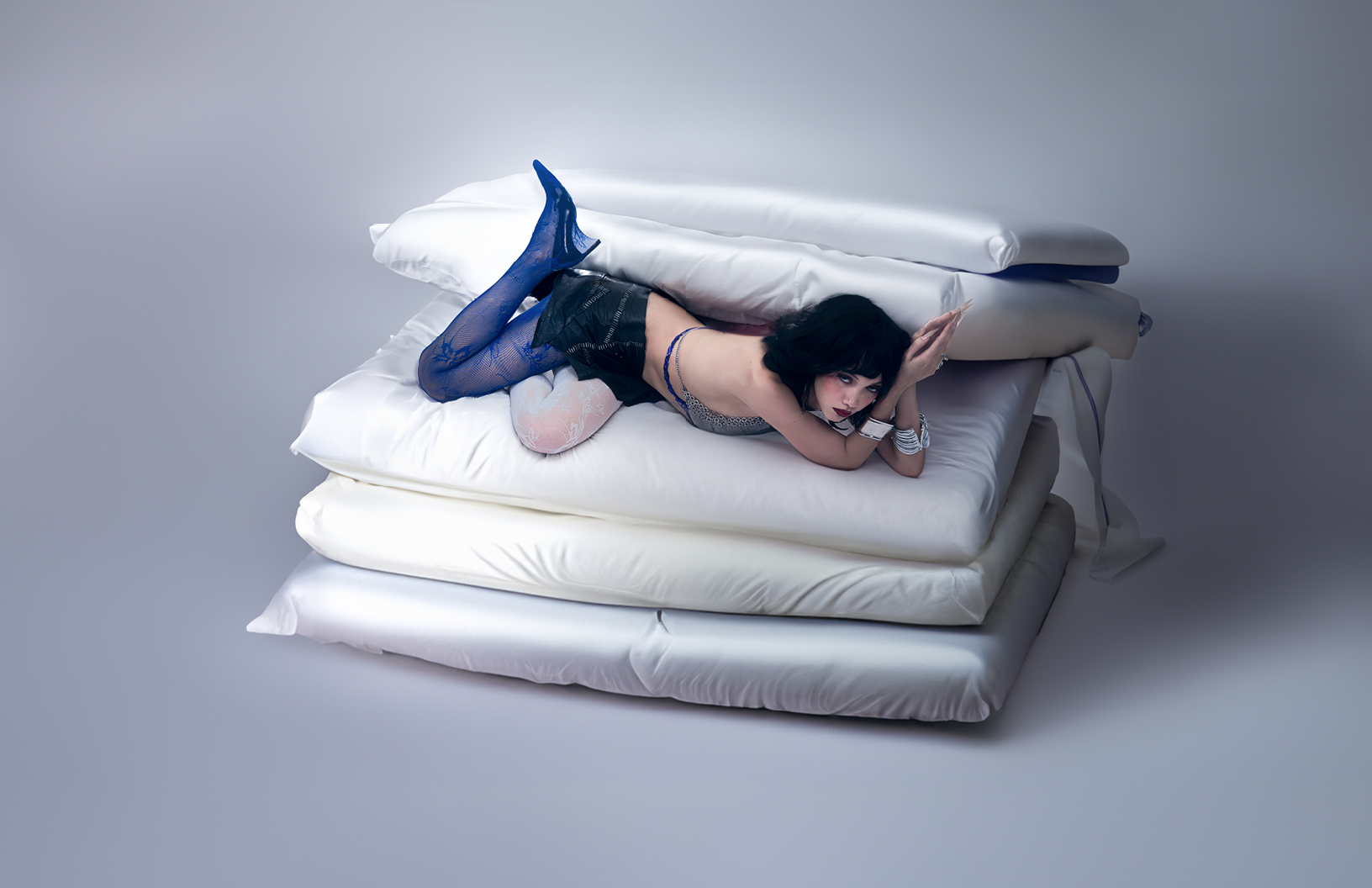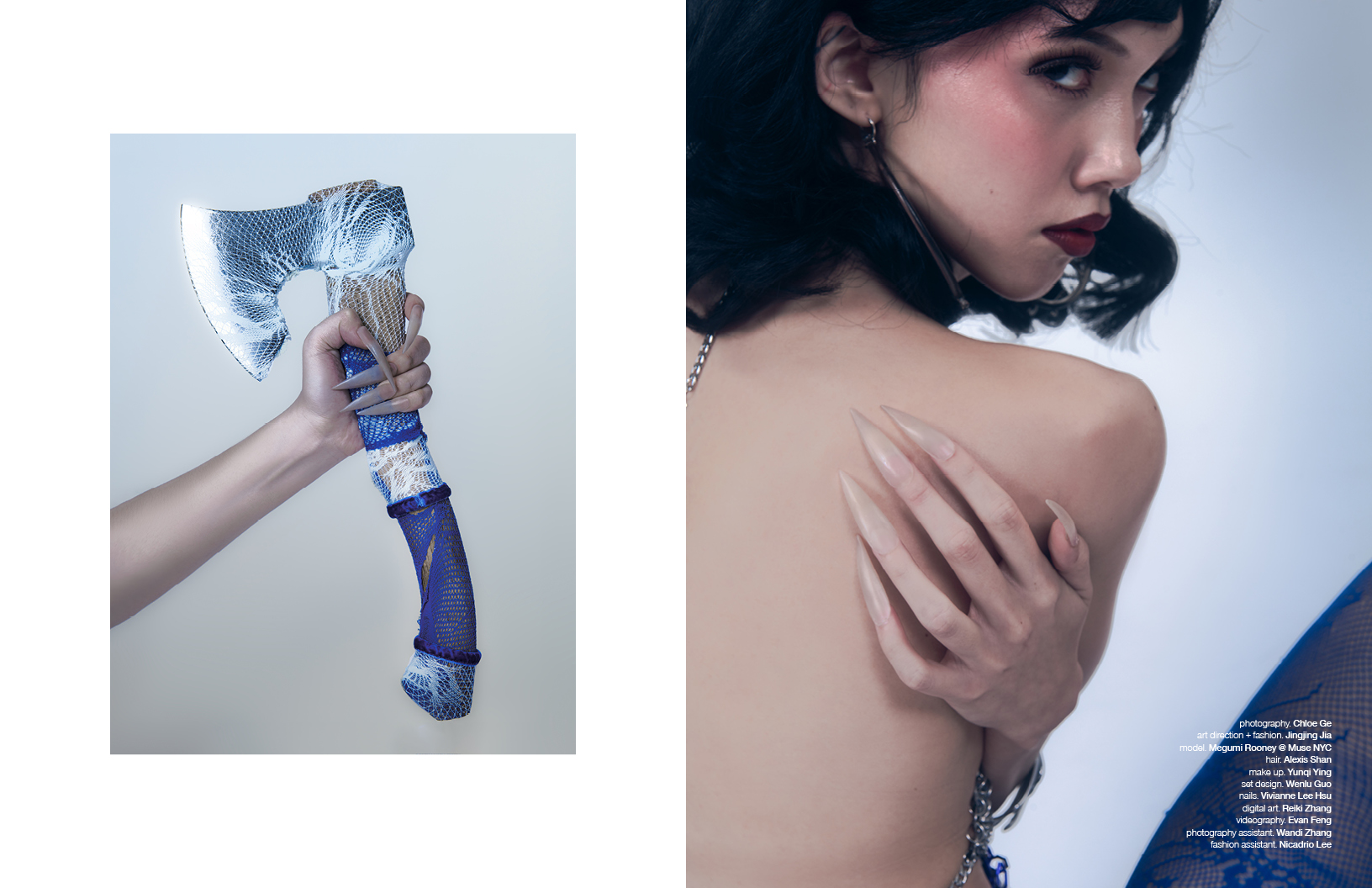Rewrite

top, earrings + leggings. Rui Zhou
skirt. TASTE OF MOON
shoes. Fey Fey Worldwide
opposite
top, earrings + leggings. Rui Zhou
skirt. TASTE OF MOON
Jingjing Jia, a Chinese stylist and creative director, is redefining the fashion landscape with her seamless fusion of avant-garde aesthetics and timeless elegance. With an innovative approach that merges bold creativity with refined sophistication, Jia crafts fashion narratives that transcend traditional boundaries between art and storytelling, as depicted in her editorial titled “Beneath the Surface.”
“The inspiration for “Beneath the Surface” came from a desire to explore how fashion and creativity can reveal layers of identity that often remain unseen,” Jia states to Schön!. “I wanted to challenge the idea of clothing and styling as merely decorative, instead using them as tools to express deeper emotions and narratives.” The imagery focuses on the intricate and intimate relationship between our personal identities and how we incorporate our clothes into that — using tights, body painting, and projections. By using the body as a dynamic canvas, “Beneath the Surface” reinterprets beauty, challenging the distinctions between outer appearance and inner essence.
Schön! chats with Jingjing Jia about her work as a creative director, the inspiration and motivation behind “Beneath the Surface,” and more.
You seamlessly blend avant-garde aesthetics with timeless elegance. Which designers or artists have influenced your unique style the most?
I believe every interesting designer or artist in the world has influenced me in different ways at different moments. Lately, I’ve been particularly inspired by photographer Tim Walker. When revisiting his earlier works, I was struck by how he elevates fashion photography by treating clothing and styling as integral parts of his storytelling rather than mere adornments.
In the “Beneath the Surface” editorial, you explore the interplay between identity and artistry. Can you elaborate on the inspiration behind this concept and how you approached its execution?
The inspiration for “Beneath the Surface” came from a desire to explore how fashion and creativity can reveal layers of identity that often remain unseen. I wanted to challenge the idea of clothing and styling as merely decorative, instead using them as tools to express deeper emotions and narratives. The approach was rooted in treating the human body as a canvas, blending elements of fashion, body art, and conceptual props to create a visual story. Each piece, from the clothing to the hand-crafted props, was carefully chosen to convey a sense of vulnerability and complexity, encouraging viewers to question what lies beneath external appearances.
Body painting and projections are prominent elements in your latest editorial. How do these techniques contribute to the overall narrative you aim to convey?
Body painting and projections served as transformative tools to highlight the interplay between the physical and the emotional in the editorial. These mediums allowed the human form to transcend its natural boundaries, becoming a dynamic canvas that reflects both individuality and universality. The body painting symbolized the idea of identity being fluid, adaptable, and deeply personal, while the projections added an ethereal quality, suggesting that identity is shaped not only by our internal selves but also by the external world. Together, they created a visual language that invited viewers to look beyond the surface and consider the intricate layers that make us who we are.
Your creations often blur the boundaries between art and storytelling. What role do you believe fashion plays in shaping and expressing human identity?
Through fashion, people express their interests, distinguish themselves from others, or find a sense of belonging with like-minded individuals. However, fashion can only offer a glimpse into someone’s personality—it’s merely the “surface layer” of understanding a person.
Can you share some of the challenges you faced while creating the “Beneath the Surface” editorial and how you overcame them?
After the initial shoot, I felt something was missing. While the human form was a strong focal point, I wanted to add another layer of depth to the narrative. To address this, I ended up DIY-ing a hatchet and a picture frame to incorporate into the shoot. As someone who graduated with a business degree rather than an art background, I often feel nervous about creating “art pieces” from scratch. However, each time I complete one, I feel an immense sense of accomplishment. These pieces are priceless to me because they embody both my effort and vision, making them deeply personal additions to the project.
The concept of transforming the body into a dynamic canvas is intriguing. How do you select and collaborate with models and artists to bring such innovative ideas to life?
The artists involved in this project are my friends, and I feel grateful and honored that they were willing to help me bring this editorial to life. The atmosphere during the shoot was relaxed and collaborative, thanks to their presence. The model, Megumi, was the only professional model I reached out to because I felt an instant connection with her. This was our first collaboration, and she was willing to try creative requests that most models might shy away from. Her contributions truly elevated the editorial.

dress. BRIAH ARTEMIS
heels. STUART WEIZMAN
leggings. Stylist’s Own
opposite
dress. BRIAH ARTEMIS
leggings. Stylist’s Own
As a creative director and stylist, what is your process for developing a new project from initial idea to final execution?
I always start with a general framework for the shoot but avoid setting rigid themes. In most creative projects, fixing a theme too early can make the process stressful if things deviate from the plan. I stay open to possibilities and embrace so-called “mistakes,” as they often lead to the most unique results.
Can you discuss a specific piece or look from the “Beneath the Surface” editorial that holds particular significance for you? What story does it tell?
Every look in this editorial is significant because they each serve as a medium for expressing the “surface.” However, one shot that stands out is of Megumi(model) in a green outfit, posed in a way that reinterprets an iconic photograph of Shelley Duvall taken by Bert Stern for Vogue in 1971. Megumi’s resemblance to Shelley inspired me to recreate the pose but with a twist in direction. It’s a tribute to Shelley, who passed away this year. May she rest in peace.

top. PerceptionF
heels. Stuart Weizman
bracelet. byeCarol
leggings. Stylist’s Own
opposite
earrings. NOIRpearl
bracelet. byeCarol
leggings. Stylist’s Own
What message or emotion do you hope viewers take away from the “Beneath the Surface” editorial?
I hope to leave it blank. I don’t want my interpretation to influence the viewer’s initial reaction. The first instinctive impression is always the most authentic.
Looking ahead, what new themes or techniques are you excited to explore in your future projects, and how do you see your style evolving?
In the future, I want to explore themes based on my personal memories. I’m a nostalgic person, but dwelling too much in the past can hinder progress. Through my work, I aim to narrate past experiences while blending them with contemporary trends, reshaping them into the idealized versions I hold in my mind. I see my style becoming increasingly inclusive—I want viewers to look at my styling and creations and wonder, “What would it feel like to try this style myself?”
Learn more about Jingjing Jia at.jingjing-jia.com.
photography. Chloe Ge
art direction + fashion. Jingjing Jia
model. Megumi Rooney @ Muse NYC
hair. Alexis Shan
make up. Yunqi Ying
set design. Wenlu Guo
nails. Vivianne Lee Hsu
digital art. Reiki Zhang
videography. Evan Feng
photography assistant. Wandi Zhang
fashion assistant. Nicadrio Lee
in HTML format, including tags, to make it appealing and easy to read for Japanese-speaking readers aged 20 to 40 interested in fashion. Organize the content with appropriate headings and subheadings (h1, h2, h3, h4, h5, h6), translating all text, including headings, into Japanese. Retain any existing
tags from

top, earrings + leggings. Rui Zhou
skirt. TASTE OF MOON
shoes. Fey Fey Worldwide
opposite
top, earrings + leggings. Rui Zhou
skirt. TASTE OF MOON
Jingjing Jia, a Chinese stylist and creative director, is redefining the fashion landscape with her seamless fusion of avant-garde aesthetics and timeless elegance. With an innovative approach that merges bold creativity with refined sophistication, Jia crafts fashion narratives that transcend traditional boundaries between art and storytelling, as depicted in her editorial titled “Beneath the Surface.”
“The inspiration for “Beneath the Surface” came from a desire to explore how fashion and creativity can reveal layers of identity that often remain unseen,” Jia states to Schön!. “I wanted to challenge the idea of clothing and styling as merely decorative, instead using them as tools to express deeper emotions and narratives.” The imagery focuses on the intricate and intimate relationship between our personal identities and how we incorporate our clothes into that — using tights, body painting, and projections. By using the body as a dynamic canvas, “Beneath the Surface” reinterprets beauty, challenging the distinctions between outer appearance and inner essence.
Schön! chats with Jingjing Jia about her work as a creative director, the inspiration and motivation behind “Beneath the Surface,” and more.
You seamlessly blend avant-garde aesthetics with timeless elegance. Which designers or artists have influenced your unique style the most?
I believe every interesting designer or artist in the world has influenced me in different ways at different moments. Lately, I’ve been particularly inspired by photographer Tim Walker. When revisiting his earlier works, I was struck by how he elevates fashion photography by treating clothing and styling as integral parts of his storytelling rather than mere adornments.
In the “Beneath the Surface” editorial, you explore the interplay between identity and artistry. Can you elaborate on the inspiration behind this concept and how you approached its execution?
The inspiration for “Beneath the Surface” came from a desire to explore how fashion and creativity can reveal layers of identity that often remain unseen. I wanted to challenge the idea of clothing and styling as merely decorative, instead using them as tools to express deeper emotions and narratives. The approach was rooted in treating the human body as a canvas, blending elements of fashion, body art, and conceptual props to create a visual story. Each piece, from the clothing to the hand-crafted props, was carefully chosen to convey a sense of vulnerability and complexity, encouraging viewers to question what lies beneath external appearances.
Body painting and projections are prominent elements in your latest editorial. How do these techniques contribute to the overall narrative you aim to convey?
Body painting and projections served as transformative tools to highlight the interplay between the physical and the emotional in the editorial. These mediums allowed the human form to transcend its natural boundaries, becoming a dynamic canvas that reflects both individuality and universality. The body painting symbolized the idea of identity being fluid, adaptable, and deeply personal, while the projections added an ethereal quality, suggesting that identity is shaped not only by our internal selves but also by the external world. Together, they created a visual language that invited viewers to look beyond the surface and consider the intricate layers that make us who we are.
Your creations often blur the boundaries between art and storytelling. What role do you believe fashion plays in shaping and expressing human identity?
Through fashion, people express their interests, distinguish themselves from others, or find a sense of belonging with like-minded individuals. However, fashion can only offer a glimpse into someone’s personality—it’s merely the “surface layer” of understanding a person.
Can you share some of the challenges you faced while creating the “Beneath the Surface” editorial and how you overcame them?
After the initial shoot, I felt something was missing. While the human form was a strong focal point, I wanted to add another layer of depth to the narrative. To address this, I ended up DIY-ing a hatchet and a picture frame to incorporate into the shoot. As someone who graduated with a business degree rather than an art background, I often feel nervous about creating “art pieces” from scratch. However, each time I complete one, I feel an immense sense of accomplishment. These pieces are priceless to me because they embody both my effort and vision, making them deeply personal additions to the project.
The concept of transforming the body into a dynamic canvas is intriguing. How do you select and collaborate with models and artists to bring such innovative ideas to life?
The artists involved in this project are my friends, and I feel grateful and honored that they were willing to help me bring this editorial to life. The atmosphere during the shoot was relaxed and collaborative, thanks to their presence. The model, Megumi, was the only professional model I reached out to because I felt an instant connection with her. This was our first collaboration, and she was willing to try creative requests that most models might shy away from. Her contributions truly elevated the editorial.

dress. BRIAH ARTEMIS
heels. STUART WEIZMAN
leggings. Stylist’s Own
opposite
dress. BRIAH ARTEMIS
leggings. Stylist’s Own
As a creative director and stylist, what is your process for developing a new project from initial idea to final execution?
I always start with a general framework for the shoot but avoid setting rigid themes. In most creative projects, fixing a theme too early can make the process stressful if things deviate from the plan. I stay open to possibilities and embrace so-called “mistakes,” as they often lead to the most unique results.
Can you discuss a specific piece or look from the “Beneath the Surface” editorial that holds particular significance for you? What story does it tell?
Every look in this editorial is significant because they each serve as a medium for expressing the “surface.” However, one shot that stands out is of Megumi(model) in a green outfit, posed in a way that reinterprets an iconic photograph of Shelley Duvall taken by Bert Stern for Vogue in 1971. Megumi’s resemblance to Shelley inspired me to recreate the pose but with a twist in direction. It’s a tribute to Shelley, who passed away this year. May she rest in peace.

top. PerceptionF
heels. Stuart Weizman
bracelet. byeCarol
leggings. Stylist’s Own
opposite
earrings. NOIRpearl
bracelet. byeCarol
leggings. Stylist’s Own
What message or emotion do you hope viewers take away from the “Beneath the Surface” editorial?
I hope to leave it blank. I don’t want my interpretation to influence the viewer’s initial reaction. The first instinctive impression is always the most authentic.
Looking ahead, what new themes or techniques are you excited to explore in your future projects, and how do you see your style evolving?
In the future, I want to explore themes based on my personal memories. I’m a nostalgic person, but dwelling too much in the past can hinder progress. Through my work, I aim to narrate past experiences while blending them with contemporary trends, reshaping them into the idealized versions I hold in my mind. I see my style becoming increasingly inclusive—I want viewers to look at my styling and creations and wonder, “What would it feel like to try this style myself?”
Learn more about Jingjing Jia at.jingjing-jia.com.
photography. Chloe Ge
art direction + fashion. Jingjing Jia
model. Megumi Rooney @ Muse NYC
hair. Alexis Shan
make up. Yunqi Ying
set design. Wenlu Guo
nails. Vivianne Lee Hsu
digital art. Reiki Zhang
videography. Evan Feng
photography assistant. Wandi Zhang
fashion assistant. Nicadrio Lee
and integrate them seamlessly into the new content without adding new tags. Ensure the new content is fashion-related, written entirely in Japanese, and approximately 1500 words. Conclude with a “結論” section and a well-formatted “よくある質問” section. Avoid including an introduction or a note explaining the process.












